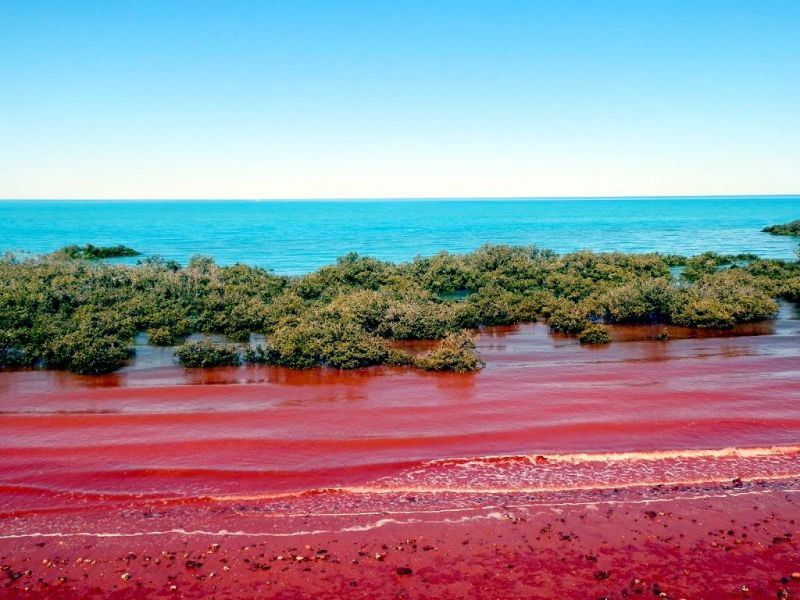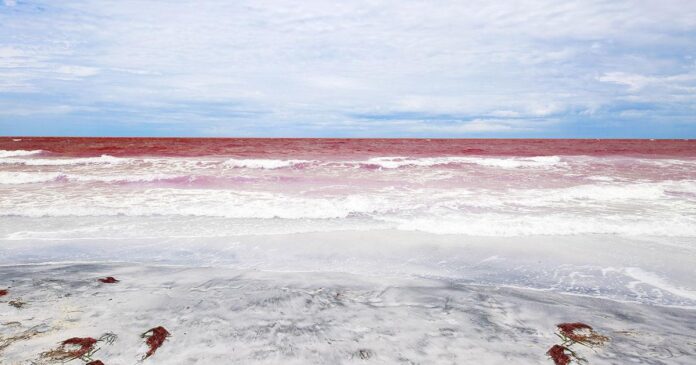Red Tide has been reported to have been seen in Florida waters and the Gulf of Mexico since Europeans first landed on the shores of the Sunshine State. In normal concentrations, the naturally occurring (and always present) Karenia Brevis organism that causes red tide in the ocean is harmless to humans and wildlife, but when water conditions are correct, the reddish hued organic material can multiply quickly, prevent sunlight from entering the water and harm shellfish and other wildlife while also irritating human skin and respiration whenever an extreme amount of the micro-organisms are present in salt water.
Florida red tide comes from the Gulf of Mexico and can also be found in saltwater bays but cannot survive in freshwater systems such as lakes and rivers.
Karenia Brevis typically blooms in the late summer or fall in offshore Gulf of Mexico patches of warm water that sometimes get pushed into the shoreline when strong winds and currents bring the ‘tide’ inshore. With the Gulf of Mexico waters becoming warmer each year due to El Nino, weather conditions are ripe for creating more cases of red tide.

While red tide occurs naturally in the Gulf of Mexico, and elsewhere in the world, knowing when and where the tide might emerge each year is a daunting but essential task to keep the public informed about this annual nuisance. After extensive research, the scientists from The University of South Florida have uncovered the true cause of Florida Red Tide and they believe they can begin to predict when and where future blooms might develop.
Robert Weisberg, a Professor of Physical Oceanography at the University of South Florida’s College of Marine Science and the lead author of the USF red tide research report reconfirmed that red tide occurs naturally in the Gulf of Mexico and revealed that the “Loop Current” was responsible for creating the conditions that cause a Florida Red Tide algae bloom. He said, “although biology and chemistry control the growth of the blooms, it is ocean circulation that unites the nutrients with sunlight to facilitate photosynthesis.” Professor Weisberg stated, “Ocean circulation also transports offshore blooms to the coast. If the circulation conditions are not right, then a red tide will neither bloom, nor manifest along the coastline. When the Loop Current interacts with the shelf slope near the Dry Tortugas it can set the entire shelf in motion, bringing new nutrients onto the shelf from the deeper ocean. This sequence of events suppresses red tide by favoring other, faster growing phytoplankton.” The USF report concluded that the position of the Loop Current in spring and early summer provides a predictor of fall red tide conditions.
Mote Marine Laboratory, a leading scientific expert on Florida Red Tide, has confirmed that red tide is not related to fresh water discharges from lake Okeechobee as some activist groups have propagated. Mote Marine announced, “In contrast to algae species that are fueled by nutrient pollution associated with urban or agricultural runoff, there is no direct link between nutrient pollution and the frequency or severity of red tides caused by Karenia Brevis. Florida red tides develop 10-40 miles offshore, away from man-made nutrient sources. Red tides occurred in Florida long before human settlement, and severe red tides were observed in the mid-1900s before the state’s coastlines were heavily developed.” They also explained how the Algae requires salt water to survive, stating, “The Florida red tide can be found in bays but not in freshwater systems such as lakes. Because Karenia Brevis cannot tolerate low-salinity waters for very long, blooms usually remain in salty coastal waters and do not penetrate upper reaches of estuaries.”
Although certain activist groups have tried to blame red tide fish kills on recent fresh water discharges from Lake Okeechobee, most of the red tide occurs far away from the Caloosahatchee River that connects Lake O to the Gulf of Mexico.
In their April 2016 Red Tide Report, The Florida Fish and Wildlife Commission reported that red tide had appeared in many Tampa area coastlines and extending several miles offshore. The toxins from the tide killed many fish in the area and helped encourage activists to blame recent fresh water discharges from Lake Okeechobee for causing the red tide and for killing the fish, although there was practically no trace of red tide in Fort Myers waterways extending into the Lake. In fact, the red tide readings decreased substantially between testing locations as they were moved from Tampa to the Fort Myers/Caloosahatchee River inlet. Readings for red tide around Fort Myers beaches when fresh water discharges were underway indicated the organism was “Not Present” in the Caloosahatchee River.
